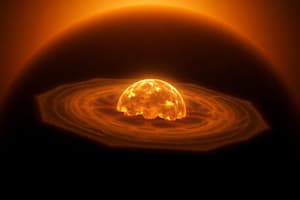Podcast
Questions and Answers
What determines the gravitational pull according to the text?
What determines the gravitational pull according to the text?
Distance and mass determine gravitational pull.
Explain how an orbit balances forward motion and the pull of gravity from another body in space.
Explain how an orbit balances forward motion and the pull of gravity from another body in space.
An orbit balances forward motion (inertia) and the pull of gravity from another body in space by ensuring that if forward movement is too strong, the object speeds past without orbiting, and if the gravity is too strong, the object crashes.
What dictates the shape of an object's orbit according to the text?
What dictates the shape of an object's orbit according to the text?
An object's speed dictates the shape of its orbit.
What keeps the solar system in orbit around the center of the Milky Way Galaxy?
What keeps the solar system in orbit around the center of the Milky Way Galaxy?
In what shape do the planets in our solar system have their orbits, and how is Earth's orbit described?
In what shape do the planets in our solar system have their orbits, and how is Earth's orbit described?
Explain how gravity influences the paths of objects in space.
Explain how gravity influences the paths of objects in space.
What determines the shape of an object's orbit in space?
What determines the shape of an object's orbit in space?
Describe the orbits of the planets in our solar system.
Describe the orbits of the planets in our solar system.
How does the presence of a massive black hole at the center of the Milky Way impact the solar system?
How does the presence of a massive black hole at the center of the Milky Way impact the solar system?
Explain the relationship between galaxies and the center of their gravity.
Explain the relationship between galaxies and the center of their gravity.
Who first developed the nebular hypothesis?
Who first developed the nebular hypothesis?
What scientific disciplines are interwoven in the development of the nebular hypothesis?
What scientific disciplines are interwoven in the development of the nebular hypothesis?
When did the Space Age begin?
When did the Space Age begin?
What has challenged and refined the nebular hypothesis?
What has challenged and refined the nebular hypothesis?
How has the Solar System evolved since its initial formation?
How has the Solar System evolved since its initial formation?
Flashcards are hidden until you start studying
Study Notes
Gravitational Force
- Gravitational pull is determined by distance and mass.
- Gravity acts towards the center of a mass, resulting in spherical shapes for celestial bodies like planets.
- Gravitational strength diminishes as distance from the mass increases.
- Gravity governs the trajectories of all objects in space, influencing their motion.
- Orbits are formed when an object’s inertia and gravitational pull from another body are balanced.
- If an object's forward motion is too strong, it can skip past a celestial body rather than enter an orbit; excessive gravity can cause a collision.
Orbits of Planets
- The planets in the solar system exhibit slightly elliptical orbits, resembling egg shapes.
- Earth's orbit is nearly circular, facilitating a consistent speed as it revolves around the sun.
Beyond the Solar System
- The entire solar system orbits around the center of the Milky Way Galaxy.
- A massive black hole located at the center of the Milky Way is responsible for maintaining the orbit of the solar system.
- Galaxies exist in clusters, which orbit around a common gravitational center.
Studying That Suits You
Use AI to generate personalized quizzes and flashcards to suit your learning preferences.





